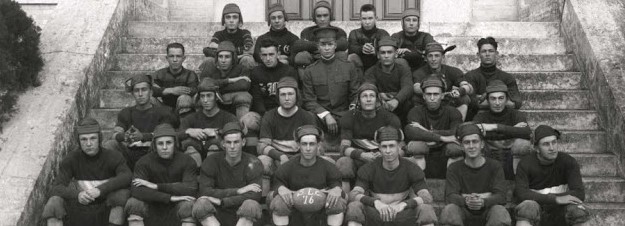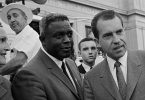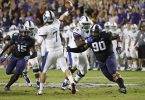Staggering is a word often associated with the largest seaborne invasion in history, marking the beginning of the end of the horrors of Nazi Germany.
In one night — 75 years ago this week — 175,000 men and equipment, including 50,000 vehicles, made the journey across upwards of 100 miles of open water for the beaches and cliffs of Normandy’s Côte Fleurie. The operation also included thousands of sea vessels, 11,000 aircraft and the coordination of 350,000 soldiers of the French Resistance.
That makes moving 22 players around in football schemes seem as uncomplicated as doing nothing, even at the speeds they play these days, compared to what Dwight Eisenhower and his staff achieved on June 6, 1944.
History leads to the belief that the commander of Operation Overlord would have been quite the football coach.
And, in fact, Ike was a football coach, a very good one, according to two assessments, most often with intramural Army teams at various posts during a career that before the war wasn’t anything of the stuff of the best-selling non-fiction books he became.

“Coaching more football” was a phrase seen often in accounts of his stops as an Army officer.
He possessed, as good leaders do, all those things good football coaches excel at.
An uber-organized, strategic thinker with a tactical view and a relationship builder whom coaches and players trust.
It takes a special leader to blend the personalities of Patton and Montgomery and all the other Type A’s into a cohesive, effective force.
The subject matter is one few historians have explored.
Ike’s football career is known. He played parts of one season on the West Point varsity before a knee injury ended that pursuit. He almost left the academy because he couldn’t play football anymore.
But the sport, as well as baseball, was important to him, so much so that as a high school freshman he preferred to risk death than lose a leg because of an infection that had become so bad a doctor recommended amputation.
“I’d rather be dead than crippled, and not be able to play ball,” Ike recalled in his memoir At Ease: Stories I Tell my Friends. “Doctors were frustrated by my attitude. But my parents understood. While they were against such contact sports as football, they agreed to accept my decision.”
Ike missed so much time at school because of the infection that he had to repeat his freshman year.
It would be difficult, he said years later, “to overemphasize the importance I attached to participation in sports.”
“I believe that football, perhaps more than any other sport, tends to instill in men the feeling that victory comes through hard — almost slavish — work, team play, self-confidence, and an enthusiasm that amounts to dedication.”
Ike was the subject of controversy over alleged participation in a semi-pro baseball team in Kansas during or just after high school, thereby compromising his amateur status. The accusation was either denied or ignored by the general and his staff over the years, but Mel Ott, the major-leaguer, swore that “the General admitted that as a youth he had [played semi-pro ball] under the assumed name of Wilson.”
After graduation from West Point in 1915 – the class the stars fell on … 59 of the class of 164 attained the rank of general — the newly commissioned lieutenant was assigned to Fort Sam Houston in San Antonio. The city was also home to the Peacock Military Academy, designated an honor school in 1908 by the Department of the Army.
Peacock administrators asked Eisenhower to coach the football team, an overture Ike initially declined, believing he lacked the time to be both an exceptional Army officer and a football coach.
Gen. Frank Funston, the post commander, ordered Ike to take the job. Any chance to lead young men is an opportunity to grow.
The topic is one the San Antonio Express News has explored.
“Those who have seen this officer operate with a football squad believe him to be one of the best coaches in Texas — bar none,” a correspondent wrote at the time of Ike’s season at Peacock.
The next season, Ike moved up to the college level, again encouraged by a superior to take the job offered by St. Mary’s of San Antonio.
Then St. Louis College had been dreadful. Cleveland Browns terrible. The Catholic brothers and priests who had coached the team literally turned the other check, going winless in the school’s first four seasons. Losses included margins of 50-0 and 80-0.
Ike, however, turned them around.
After tying its opener under Supreme Commander Eisenhower, St. Louis won its next five games and closed 5-1-1.
“We thought more of him than we did of any other coach we ever had,” said quarterback Jim Sweeney, a quote found in the archives of the San Antonio Express. “We respected him from the time he showed up until he left. He was very frank and honest, and we learned more about honor and discipline from him than we did anywhere else.”
Watching every minute of every game that season were Ike’s new bride, Mamie, so adored she remains the only woman to receive a St. Louis or St. Mary’s football letter, and her parents.

“We fought as much for Mamie and the Douds [Mamie’s parents] as we did the school,” Sweeney said.
That was his only season at St. Mary’s. Officer life demanded Ike and Mamie move.
If the coaching profession paid as well then as now, who knows? Ike might have been Bill Parcells.
No one will ever know.
It’s fairly clear, though, that Ike’s coaching stints in San Antonio were part of his evolution as the man who saved the world from the designs of evil men.







